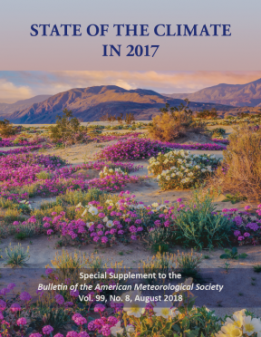ARL Scientist Plays Key Role in Developing State of the Climate in 2017 Report
August 2018
August 2018
ARL’s Climate Science Program Manager, Dr. Howard Diamond, served as the lead editor for Chapter 4, The Tropics; a role he has performed since 2006. The Tropics chapter addresses several oceanic and atmospheric conditions, including the state of global climate influences such as the El Niño Southern Oscillation, as well as global tropical cyclone activity (e.g., hurricanes, typhoons, and cyclones) in seven ocean basins. Three sidebar articles in the chapter focus on the variety of intensity and precipitation records set by Hurricanes Harvey and Irma, as well as utilization of the new GOES-16 satellite for improved storm monitoring.
As the title denotes, this publication examines climate indicators and weather events worldwide. Over 450 scientists from more than 60 countries contributed to the annual, peer-reviewed report in this, its 28th year of publication. NOAA and the American Meteorological Society announced the report and its findings yesterday. The latter will issue State of the Climate in 2017 as a special supplement to the August 2018 Bulletin of the American Meteorological Society. In just a few short months, the team will begin development of the 2018 report and Diamond will resume his role as lead editor of the Tropics chapter for the thirteenth time.
For more information, please see the Tropics chapter (https://www.ametsoc.net/sotc2017/Ch04_Tropics.pdf), NOAA’s news page (http://www.noaa.gov/news/2017-was-one-of-three-warmest-years-on-record-international-report-confirms) or the full report (https://www.ametsoc.org/ams/index.cfm/publications/bulletin-of-the-american-meteorological-society-bams/state-of-the-climate/).
